Where next for the Living field! Here we look at Nourish Scotland’s Conference and Food Atlas for inspiration. We conclude that the Living Field should remain within its core areas of environment, community and healthy eating, while working towards better integration of these core activities to link agriculture and the human food chain.
The Living Field project began 19 years ago. The name and concept were proposed by Geoff Squire in 2001. The garden and its habitats were designed by Gladys Wright, built by science and farm staff and opened to the public in 2004. It’s time to assess where we are and what might come next. We therefore examine some local and international initiatives in the food chain to help judge where the Living Field stands.
Of the many organisations we have worked with over the years, Nourish Scotland [1] offers the most comprehensive set of practical aims based on improving the food chain as a system, as a set of connected and interdependent parts that need to evolve as a whole.

Here we look at one of Nourish’s achievements – the Conference held earlier in November 2019. Their Food Atlas of 2018 will be featured later. In each case, Nourish defined those parts of the system that need to be in good shape for the whole to work effectively.
The Nourish system goes well beyond the biophysical properties of soil, agronomy and climate to include human health and wellbeing, the end of malnutrition and hunger in Scotland and the cultural and political will to make this happen. As a further step in our own evolution, we consider those topics from the Conference in which the Living Field already operates and those it might need to move in to.
Nourish Conference 2019

The Conference held in Edinburgh 21-22 November 2019 aimed to devise a Game Plan for a Good Food Nation. Its basic premise is that the food system is broken and needs radical change. It brought together people with a very wide range of interests and expertise. (Nourish will publish a full report in due course.)
People attending were divided into groups of about 8, each group to consider where things stand and what can be done to bring about major change. A diagram, designed by the Centre for Food Policy, City University [2], helped to guide discussion: the food chain lies in the centre, surrounding by five ‘domains’ or ‘spheres’ that affect and are affected by the food chain – environment, society, economy, politics and health (Fig. 1). Each person indicated their expertise by placing paper dots on the diagram. The domains were all well covered.
The Food Chain and its five spheres
The Food Chain in the centre is made up of of 8 topics [3]. The five surrounding ‘spheres of sustainability’ go farther than the widely used three (environment, economics and society) or four (those plus politics) to include health. Each sphere consisted of 6 essential topics [listed at 3].

Fig. 1 Food chain diagram (top left) used at the Nourish Conference reinterpreted to show main activity in the Living Field project: the bigger the letters, the greater the activity in the Living Field. Full list of topics at [3]. The food chain diagram was created by the Center for Food Policy, City University [2], used with thanks.
The diagram is shown upper left in Fig. 1, but to examine our activities more closely, the spheres are reproduced as boxes drawn in the same colours as in the original. Each box lists those sub-topics that the Living Field has been active in over the past 15 or more years. We have a strong base in many topics of the Food Chain from production to eating, but have done little in processing, retail and waste.
Of the surrounding spheres, most activity has been in three – Environment, Health and Society – where we combine practical knowledge in the garden and farm with online activity in this web site.
Looking at the possibilities, it would be difficult for us, with a base in the Garden, to move far into economics and politics. Rather, the scope for expansion lies through improving the connections and overall integration among topics that we already cover, with some additions such as waste.
For those readers with long-term interest in the Living Field and its future, we summarise below our work on the Food Chain and in the spheres of Environment, Society and Health, providing links in each case to articles on this web site. Finally, we look to the future.
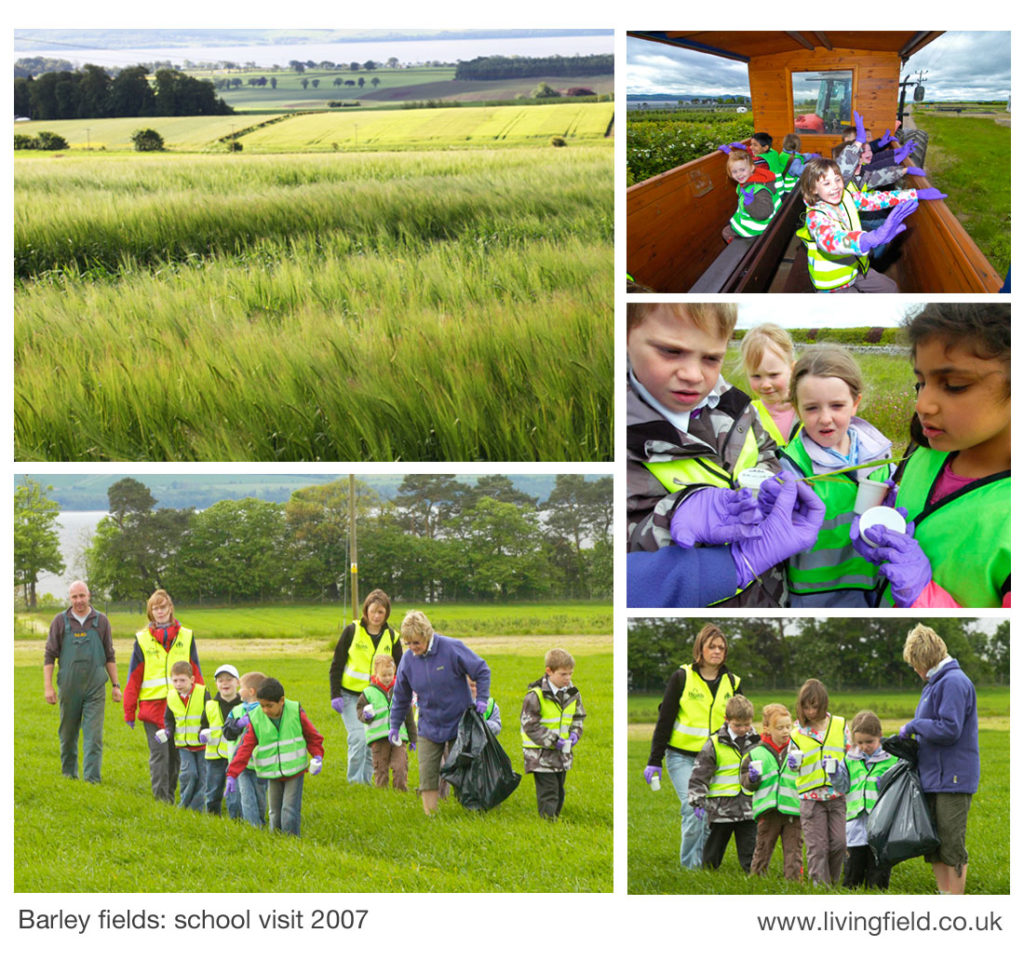
Fig. 2 Schoolchildren visiting fields at the James Hutton Institute, looking at crops and the bugs (invertebrates) that live in them – hosted by the Living Field.
Food Chain
The Living Field has been active in four of the main topics in the Food Chain [3]. Agricultural production and Farm inputs have been core activities, both in the garden and the surrounding farm. A range of cereals, legumes and tubers, some bred at the Institute, have been grown in most years. We have interpreted many aspects of Research and Technology and their practical application on the Hutton Farms for our audience of schools and the public. Eating has concentrated on the use of home-grown grains, pulses and vegetables.
There has been some integration of these topics. Our ‘grain to plate’ – or more graphically ‘seed to sewer’ promotions – have looked at links along important segments of the food chain. And we have explained that, while most of our food is imported and relatively little produced locally, there is scope to raise home grown production.
Examples of Living Field web articles on these topics Crop diversification. Ancient grains at the Living Field – 10 years on. Energy and light – no life without the sun. The Year. The barley timeline. The Brassica complex. Beans on toast – a liquid lunch. Three grain resilience. Effect on corn yields of the 2016 winter flood. Seed to sewer – the water footprint. Resilience to the 2018 drought. Food production from the first crops to the present day. Great quantities of aquavitae. Crop-weeds.
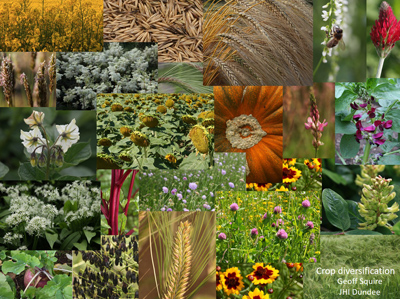
Fig. 3 Diversity of crops: panel of photographs to show the range of crops and other useful plants grown in the Living Field garden (original images by GS).
Environment
Of the 6 topics in the sphere of Environment [3], the Living Field has been active in Biodiversity, particularly as it affects ecological functioning, and Land use and Soil. The need to study and display diversity among managed and wild plants of the croplands was one of the main reasons for constructing the micro-habitats in the garden.
In Water, we have looked at both the water cycle as it affects agriculture and to a lesser degree the use of water in processing. Less emphasis has been given to Climate and Air, other than through having to respond to weather, as do all gardeners and farmers, and writing articles on climatic patterns and shifts.
Examples Pollinator plants. The meadow. Hedge and tree. Pond and ditch. Crop diversity. The late autumns floods of 2012. Resilience to the 2018 drought. Winter flood. Dust bowl ballads. The beauty of roots. Booting small scale seed production. Kidney vetch and the small blue.
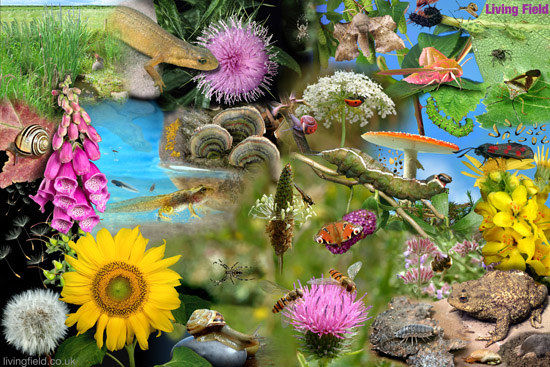
Fig. 4 Biodiversity in the Garden – collage of images taken in the Living Field garden arranged to show the micro-habitats with their plants and invertebrates, all interconnected. Original images by Stuart Malecki / Living Field.
Society
The Living Field has placed Education centrally from the beginning, offering visits from schools and the public and working with formal education to produce teaching aids, notably the Living Field CD which was distributed to all schools in Scotland and had been widely requested from overseas (though is no longer updated). Working within the wider Community has exposed many people to the issues being discussed here, for example through various open events including Open Farm Sunday and public road shows.
In Culture, we have promoted the existence of our traditional crop landraces, notable bere barley, and explained the transitions in farming that have led to the present state. Several artists and writers have worked with us to extend the Garden’s activities to new appreciative audiences.
Examples: Jean Duncan Artist. Open Farm Sunday 2019. The garden at Open Farm Sunday 2017. What are landraces. Bere line (rhymes with hairline). Tina Scopa – Edaphic Plant Art. The Crunch at Dundee Science Centre. Transition Turriefield. Shetland’s horizontal water mills. On the edge (rigs on Lewis). More than landscape. Dundee Astro. Anniversary designs and sketches.
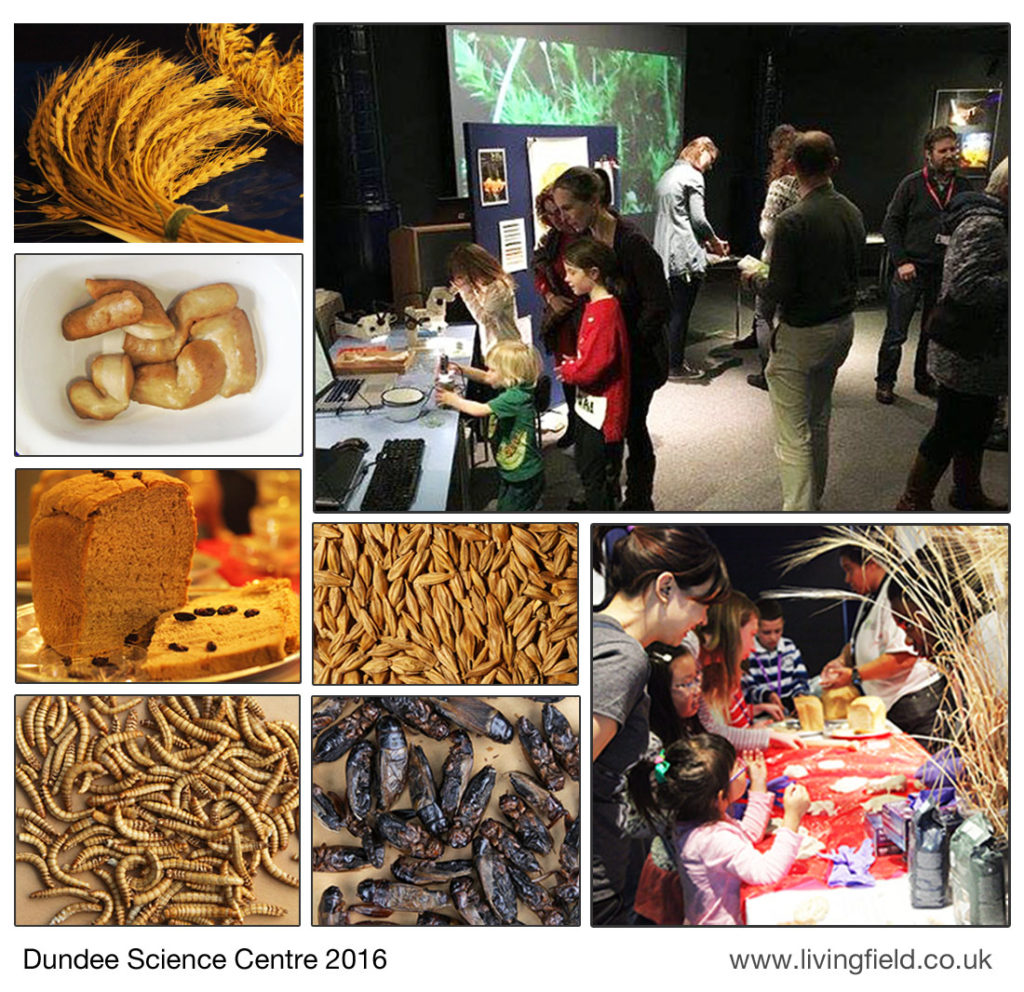
Fig. 5 Living Field roadshow at a Biodiversity Day, Dundee Science Centre, showing: top right c’wise, people at the event, learning how to make bread, two types of edible insect, bread made from insect flour, gluten and a sheaf of emmer wheat, with (centre) cereal grain.
Health
The project has promoted the benefits of healthy eating, mainly through growing and locally processing pulses, vegetables and grains. A major living exhibit in 2017 emphasised the nutritional content of different types of vegetable. The wider community has shown how to prepare and cook healthy plant products. Our work touches on food safety and general wellbeing, but much less so if at all on other topics in this category [3].
Examples Vegetables in the garden. The Garden’s vegetable bounty. Can we grown more vegetables. The vegetable map of Scotland. Legumes in the garden. Peasemeal, beremeal, oatmeal. Feel the pulse. Scofu – the indigenous Scottish tofu. 2Veg2 pellagra. Vegetables markets of the world: Little India, Inle, Bangkok.
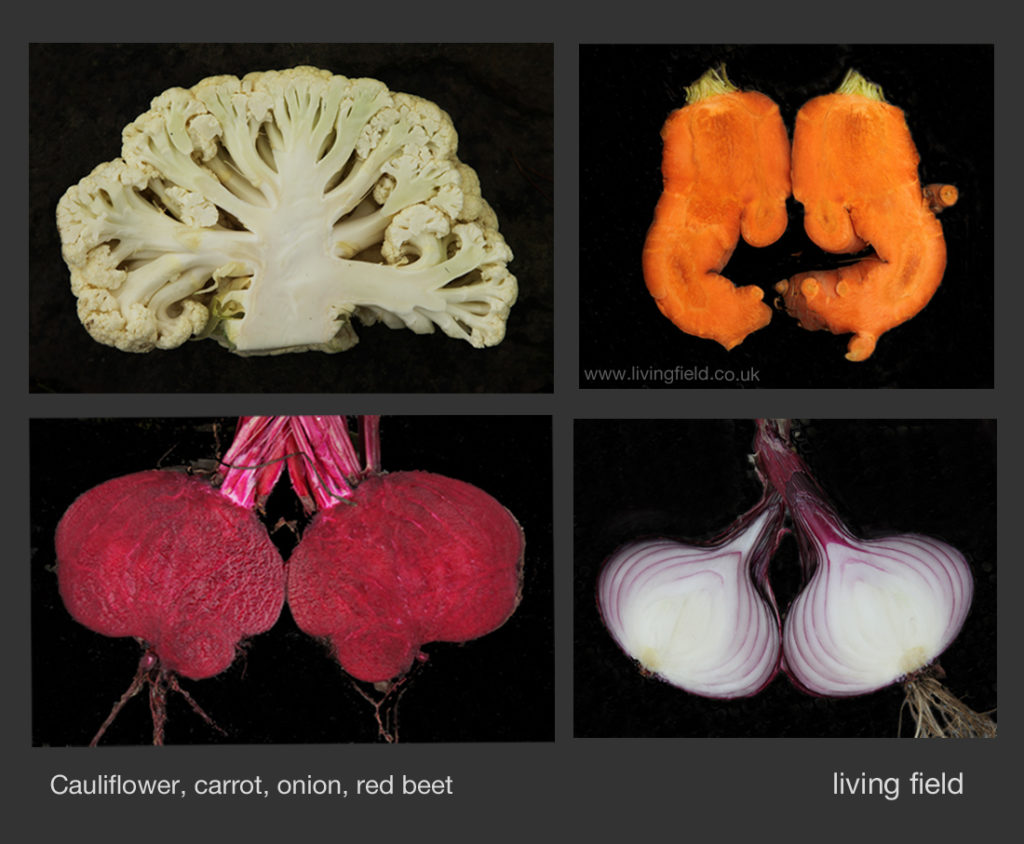
Fig. 6 Vegetables grown in the garden, sectioned: cauliflower, carrot, onion and beet (images by Living Field)
Should the Living Field expand into Politics and Economics
The Living Field project has had little activity in spheres of Politics and Economics. The web site has touched on issues in rural policy, such as CAP Greening, and value-generation, for example through new legume products, and web articles have pointed to our reliance for food security on international trade in commodities. Yet in general we have kept out of Politics and Economics.
How far then should the Living Field enter into Politics? There is scope for more activity in topics around tax and subsidy but little option, given our status as part of a research institute, to enter into debates on party politics, power relations and governance structures. We have not been a campaigning organisation. Rather, we contribute basic knowledge and experience which we hope will be useful to others.
Similarly, how far into the Economy? There is certainly scope to raise our contribution to generating value in agricultural products, mainly through public outreach in food technology as developed within the Institute. There is perhaps more scope in comparing the economics of various crops and forms of agriculture, and the associated trade in these products, but to do that would need closer involvement from those with the right skills.
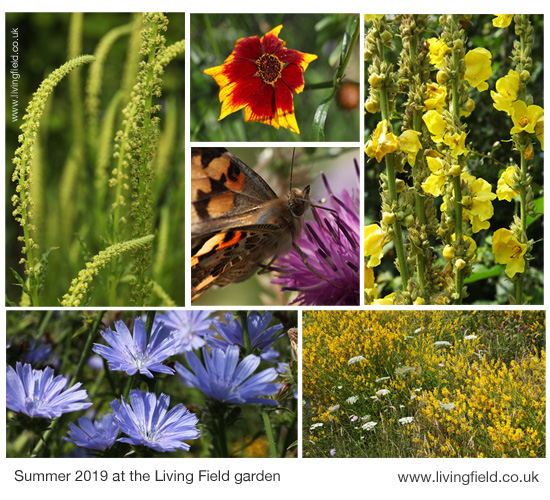
Fig. 6 Each year the garden grows a wide selection of useful plants in addition to the food crops. Here are some from 2019: top left c’wise, flowering stems of dyer’s weld, flower of dyer’s coreopsis, great mullein, dyer’s greenweed with wild carrot heads emerging, chicory flowers, and (centre) painted lady on knapweed (www.livingfield.co.uk).
Conclusions
The Centre for Food Policy’s concept of five spheres around the Food Chain is a challenge. The Living Field has worked in two of the spheres from the beginning – Environment and Society – and has increased its activity in a third – Health – for example through diet and nutrition. The other two spheres, Politics and Economy have been left to other organisations adept in these areas.
Talking to people both at the conference and elsewhere, it looks like the greatest value offered by the Living Field is to continue concentrating on its core areas. Very few small projects can grow and display year on year around 200 plant species that are or have been useful to people as food, medicinals, fibres and dyes.
In looking to the future, the work needs to be more directed. Progress since 2001 has been a fairly random walk through plants and their cultivation since the neolithic. The speed and direction of this walk have been determined mainly by external events and the interests of the community – the scientists, artists and practical people who have contributed their time, effort and knowledge to the project.
Integration along the food chain
There is scope therefore for the Living Field to take on the Food Chain more holistically by integrating Environment, Society and Health with an awareness of Economics and a nod to Politics. This more purposeful approach should show the progression of products along the food chain, developing several case studies from the cereals, pulses and vegetables.
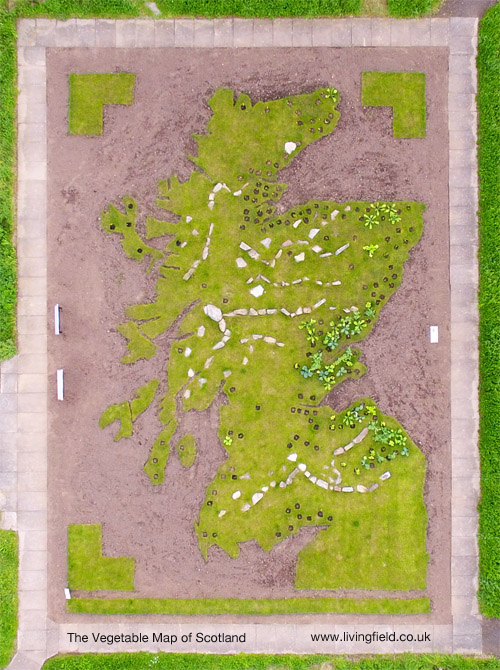
An example of how the project might operate in the future might learn from the Vegetable Map of Scotland [5]. Gladys Wright had the idea of constructing the Vegetable Map as a living entity in the Garden. The idea came from earlier web-work with Nourish in which we constructed a digital map of the country showing where the various legume and vegetable crops were grown. But when the map was made real, growing in the Living Field Garden (shown right) the wider interest was immediate – here’s the land, here are the vegetables now grown – and here’s what could be grown if the food chain was operating for the benefit of all.
We have already begun this to a degree in association with the Hutton’s lead in the EU TRUE project on legumes in the food chain [4]. Taking Scotland’s pulses, peas and beans, as an example, the Living Field has describe their history of cultivation, shown how to grow them, their agronomy and environmental benefits including nitrogen fixation, and explored the potential for new uses and higher value in products such as Scofu. Yes, the Scottish tofu!
And we could extend the line of thought and practice: here are the benefits for environment and health … and this is what it would take in the form of support to farming to achieve these benefits ….. and perhaps most important of all, here is the public buy-in and political will needed to make it happen.
There’s much to think about …. and not least where the money comes from for the next phase.
References
[1] Nourish Scotland: information on the conference at Game Plan for a Good Food Nation.
[2] Conference Food Chain diagram: Centre for Food Policy, City University of London http://www.city.ac.uk/foodpolicy. The diagram was published in the following brief: Parsons K, Hawkes C, Wells R. 2019. Brief 2: What is the food system? A Food Policy perspective. In: Rethinking Food Policy: a fresh approach to policy and practice. London: Centre for Food Policy. Available through this link.
[3] The Food Chain comprises: Farm inputs, Agricultural production, Research and technology, Processing, Distribution/transport/trade, Food retail/service, Waste/disposal and Eating. The sphere of Environment comprises: Land/sea, Soil, Water, Air, Climate and Biodiversity. That of Society: Education, Livelihoods, Gender, Media and advertising, Culture and Community. Of Health: Wellbeing, Food safety, Environmental health, Diet and nutrition, Antibiotic use and Workplace safety. Of Economy: Trade, Jobs, Skills, Competitiveness, Value generation, Allocation of resources. Of Politics: Legislation, Policy, Power relations, Tax/subsidies, Governance structures and Political parties
[4] EU TRUE Transition Paths to Sustainable legume based systems in Europe. TRUE Project home: https://www.true-project.eu/
[5] Current and potential vegetable production in Scotland was explored in an article titled Can we grow more vegetables? from which arose the living structure in the Vegetable map made real.
Contact: geoff.squire@hutton.ac.uk.
[Online 5/12/2019, minor edits and new links 17/12/2019 and28/12/2019]
